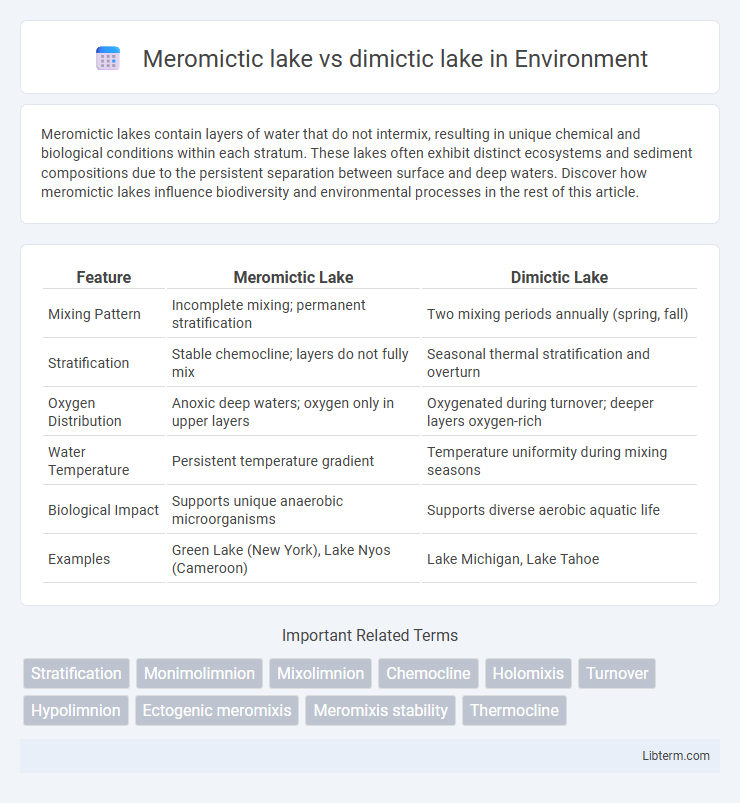Meromictic lakes contain layers of water that do not intermix, resulting in unique chemical and biological conditions within each stratum. These lakes often exhibit distinct ecosystems and sediment compositions due to the persistent separation between surface and deep waters. Discover how meromictic lakes influence biodiversity and environmental processes in the rest of this article.
Table of Comparison
| Feature | Meromictic Lake | Dimictic Lake |
|---|---|---|
| Mixing Pattern | Incomplete mixing; permanent stratification | Two mixing periods annually (spring, fall) |
| Stratification | Stable chemocline; layers do not fully mix | Seasonal thermal stratification and overturn |
| Oxygen Distribution | Anoxic deep waters; oxygen only in upper layers | Oxygenated during turnover; deeper layers oxygen-rich |
| Water Temperature | Persistent temperature gradient | Temperature uniformity during mixing seasons |
| Biological Impact | Supports unique anaerobic microorganisms | Supports diverse aerobic aquatic life |
| Examples | Green Lake (New York), Lake Nyos (Cameroon) | Lake Michigan, Lake Tahoe |
Introduction to Meromictic and Dimictic Lakes
Meromictic lakes feature layers of water that rarely mix, characterized by a permanent stratification where the deepest layer remains isolated from surface waters, often leading to unique chemical and biological conditions. Dimictic lakes experience two mixing periods annually, typically in spring and autumn, resulting in complete turnover that redistributes oxygen and nutrients throughout the water column. Understanding these lake types highlights key ecological dynamics affecting aquatic life, nutrient cycling, and water quality.
Defining Meromictic Lakes
Meromictic lakes are characterized by layers of water that do not intermix, resulting in a permanently stratified water column with distinct chemical and temperature gradients. Unlike dimictic lakes, which mix twice annually during spring and fall, meromictic lakes maintain a stable anoxic bottom layer known as the monimolimnion. This persistent stratification influences nutrient cycling, biological diversity, and sediment deposition within the lake ecosystem.
Understanding Dimictic Lakes
Dimictic lakes undergo two complete mixing periods annually, typically in spring and fall, driven by temperature changes that cause stratification and turnover. These lakes have a distinct thermal layering with warm epilimnion, cooler metalimnion, and cold hypolimnion, where oxygen distribution varies seasonally, influencing aquatic life and nutrient cycling. Understanding dimictic lakes is crucial for ecological management as their mixing patterns affect dissolved oxygen levels, water quality, and biological productivity.
Key Differences in Water Layer Mixing
Meromictic lakes experience incomplete mixing of water layers, maintaining distinct and stable layers throughout the year due to chemical or density gradients, while dimictic lakes undergo two complete mixing events annually, typically during spring and autumn, caused by temperature-induced density changes. In meromictic lakes, the bottom layer, or monimolimnion, remains isolated and anoxic, preserving unique sediment conditions, whereas in dimictic lakes, seasonal turnover promotes oxygenation throughout the water column. These differences in mixing regimes influence nutrient cycling, aquatic life habitats, and lake ecology significantly.
Chemical and Physical Properties Comparison
Meromictic lakes exhibit permanent stratification with distinct chemical layers, maintaining an anoxic monimolimnion rich in dissolved minerals, while dimictic lakes undergo seasonal mixing twice annually, promoting oxygen distribution throughout the water column. In meromictic lakes, the chemocline separates chemically distinct layers, resulting in stable gradients of salinity, nutrients, and redox potential, whereas dimictic lakes experience uniform chemical properties during turnover periods. The physical stability of meromictic lakes limits vertical mixing, preserving unique biogeochemical conditions, contrasting with the periodic thermal convection and complete mixing seen in dimictic lakes.
Ecological Implications of Mixing Patterns
Meromictic lakes maintain a permanent stratification with a stable anoxic monimolimnion, fostering unique microbial communities and preserving ancient organic matter, contrasting with dimictic lakes that undergo biannual mixing promoting oxygen redistribution and nutrient cycling. The persistent chemical gradients in meromictic lakes create specialized habitats supporting distinct biogeochemical processes, whereas dimictic lakes experience seasonal homogenization influencing primary productivity and fish habitat dynamics. These differing mixing regimes critically affect nutrient availability, carbon sequestration, and ecosystem resilience to environmental changes.
Examples of Meromictic Lakes Worldwide
Meromictic lakes such as Green Lake in New York, Lake Nyos in Cameroon, and the Black Sea exhibit permanent stratification, where deeper water layers remain largely un-mixed year-round due to chemical or density gradients. In contrast, dimictic lakes like Lake Tahoe in the USA and Lake Baikal in Russia experience biannual mixing during spring and autumn, allowing oxygen and nutrients to circulate throughout the water column. The unique chemistry and stable stratification in meromictic lakes support distinct microbial communities and biogeochemical processes absent in dimictic systems.
Notable Dimictic Lakes Around the Globe
Notable dimictic lakes around the globe include Lake Tahoe in the United States, Lake Geneva in Switzerland, and Lake Biwa in Japan, each experiencing two mixing periods annually due to temperature-driven density changes. These lakes undergo thermal stratification during summer and winter, with turnovers in spring and autumn, promoting oxygen redistribution and nutrient cycling. Unlike meromictic lakes, which have permanently stratified layers, dimictic lakes exhibit complete water column mixing twice a year, supporting diverse aquatic ecosystems.
Impacts on Aquatic Life and Biodiversity
Meromictic lakes, characterized by permanent thermal stratification, create stable but chemically distinct layers that limit oxygen penetration to deeper waters, often resulting in unique anoxic habitats supporting specialized microbial communities and reduced fish diversity. Dimictic lakes undergo seasonal mixing twice a year, promoting oxygenation throughout the water column and supporting a broader range of aquatic species by facilitating nutrient cycling and habitat variation. These differences in mixing regimes significantly influence aquatic biodiversity, with dimictic lakes generally sustaining higher fish populations and more diverse ecosystems than the often more chemically stratified and species-restricted meromictic lakes.
Conclusion: Significance of Lake Classification
Classifying lakes as meromictic or dimictic is crucial for understanding their ecological dynamics, nutrient cycling, and habitat stability. Meromictic lakes maintain layered water columns with limited mixing, fostering unique biological communities and preserving ancient sediments, while dimictic lakes undergo seasonal mixing, promoting oxygen distribution and nutrient turnover. Recognizing these differences enhances lake management strategies and aids in predicting ecosystem responses to climate change.
Meromictic lake Infographic

 libterm.com
libterm.com